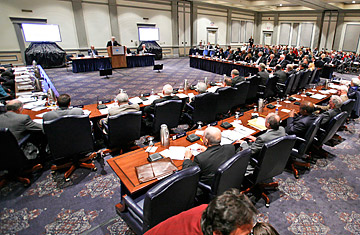
The Penn State board of trustees meets in the wake of the firing of football coach Joe Paterno and school president Graham Spanier on Nov. 11, 2011
(2 of 2)
Governor Tom Corbett said he that when graduate assistant Mike McQueary told school officials he had seen Sandusky sexually assaulting a child, he met his minimal obligation for reporting but did not meet his moral obligation. What's your take?
We can say that someone met this fine line standard within the law, but that doesn't necessarily mean that they did what was right. And that's the most troubling aspect of this for me.
What does that tell us about the culture of football and the culture of oversight at the university?
What I caution everyone to talk about is saying that this defines the culture of Penn State football. I think you saw the culture of Penn State football at the beginning of the game on Saturday [Nov. 12], when all those players got down in the middle of that field at the beginning of the game, got down on their knees and prayed for those kids. When you saw the tens of thousands of students come out not for a white-out, for a blue-out. Even though earlier in the week, there was an extremely small number of students who took to the streets, following the announcement of the coach. The culture of Penn State was better represented by the tens of thousands of kids who came out at the candlelight service on Friday night [Nov. 11]. So I'm cautious about saying things related to culture that encompasses everyone. Now, does that mean that it isn't an issue? Of course it's an issue. We have to be careful about the relationship between the football program and the rest of — or individuals in the football program and the rest of the university. But to say that this is indicative of the entire program, I think, would not be correct.
Colleges are big, powerful institutions. They have their own police forces and judicial systems, and they control when information gets passed from the on-campus authorities to those off campus. What can you say to people like us who are wondering if there are more Sandusky-type transgressions that are getting swept under the rug?
We have to be very concerned about that. We have to remember that in many circumstances, in many cases across the country, not just in Pennsylvania but across the country, these universities are small cities. These are big enterprises, multibillion-dollar enterprises, with tens of thousands of employees. Where I would look at it, as a parent of two children myself — one day we will be looking at colleges to go to — is this symbolic of the overall culture and climate at the university? Or is this the exception? Overwhelmingly, students at Penn State would say this is the exception. Overwhelmingly, that this is not symbolic of what happens at State College. And I would imagine that that would be a true statement at almost every one of our universities. But that doesn't mean it doesn't happen. And what the investigative committee will do, what the board of trustees has committed to do, what all universities should look at across the country, is to make sure they recognize that we are as vulnerable as the single student is on that campus. And in this case, unfortunately, it was a 10-year-old boy in a shower. We cannot let that happen again. So while people will make broad, general statements and try to apply it, or seek a very specific incident and make a general statement about a university, I know that's not the case for Penn State, and certainly for the students.
You said the students who were protesting were greatly outnumbered by the students who were disgusted by the protests and who went to the prayer vigil. Are there any other big misconceptions about Penn State?
One of the misperceptions is about the slowness of the board to react to this situation after it broke. You have to remember that it was four days, 96 hours, from the time that that report was made public until Spanier and Paterno were both relieved of their responsibilities. Considering the size and scope of that institution, that's quite aggressive action in a short period of time.
This interview has been edited for length and clarity.
